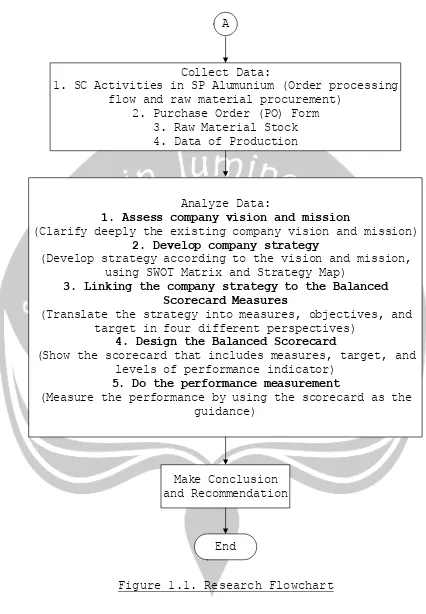1
CHAPTER 1
INTRODUCTION
1.1. Background
The global financial crisis happened in the end of 2008 has been badly affecting most of companies in our
country until now, including the small-medium
enterprises (SME). These companies are demanded to be able to retain in market competitions, and at the same time be able to improve their business performance to win the competitions.
Supply chain management (SCM) has been noted as the main part of the business, that in fact there is a study cited SCM as one of the three most important
management practices for determining performance
(Brewer and Speh, 2000). It also includes the
performance of Small Medium enterprise (manufacturer), as one of the members of supply chain. As an addition, in the efforts to increase the performance it is necessary to have a right performance measures. By using these measures it is expected that improvement could be supported.
The performance measurement system that fit within the supply chain is the Balanced Scorecard. It
translates an organization’s mission and strategy into
a set of performance measures. The advantage of this measurement system is that the scorecard measures
2
perspectives, such as, financial, customer, internal business processes, and learning and growth.
One of the small medium enterprises in Yogyakarta, named SP Alumunium, is a company that produces aluminum cookware, such as, casserole, kettle, pan, and cookie mold. The company, established in 1965, sells not only wholesale, but also to the public or retail. It has been its vision to be a leader in cookware aluminum casting industry in Yogyakarta and outside Java, and its mission to produce goods that is demanded by society in a good quality for the well-being of all. The production process in SP Alumunium is metal casting. As one of the suppliers for MAKRO all over Indonesia (about 20 outlets), the market of the company is also broader into many areas in the country. In the coming years, the company will continue to develop its production.
In order to support its business growth, the company is also demanded to improve its internal function performance by using appropriate measurement system. In the last few years, SP Alumunium has implemented common measurement system that is based on financial aspect only. One of the measures, used by the company, is the sales growth. Although the company could still run the business and make an improvement
through these measures, these traditional common
3
the future. Therefore, the company needs
instrumentation about many aspects of its performance, not only financial aspect, to guide the company in reaching its vision and mission in the future.
In this thesis, the Balanced Scorecard performance measurement system is implemented to measure internal function performance of SP Aluminium. From this research, it is expected that a set measures (metrics) are identified that could support the performance measurement and allow decision making for SP Aluminium in the future.
1.2. Problem Statement
In doing some improvements in a business
performance, a need to clearly define the measurement metrics have been recognized that financial principle is no more the only perspective to be measured presently. Therefore, a new applicable performance measurement should be acquainted to the SP Alumunium, as well as the setting of its future targets.
1.3. Research Objective
To provide appropriate measures, including its performance driver and targets, for SP Alumunium in measuring its performance from four different
perspectives (customer perspective, financial
perspective, internal business perspective, and innovation and learning perspective) by using Balanced Scorecard.
4 1.4. Scope of Research
The research is restricted to the following frameworks:
This research will be held in SP Alumunium, Yogyakarta.
The observation is focused on the internal
function of supply chain activities of the company from July 2009 to October 2009.
The research will be done by using Balanced Scorecard measurement system.
1.5. Research Methodology
a. Data for the Research Data of the Company
Data of company is gained by observation and interview method.
Data of the previous researches.
The writer will use some researches to be analyzed. All of the researches used are related with this study.
b. Step of Analysis.
5 Start
Plan the Topic of the Thesis
Initial Observation to Several SMEs in
Yogyakarta
Literature Study:
1. Supply Chain Management 2. Balanced Scorecard
Problem Statement:
A need to clearly define the measurement metrics of the company performance
Choose SP Alumunium (cookware aluminum casting company) as
the company to be observed
Research Objective:
1. To provide appropriate measures for SP Alumunium using Balanced Scorecard
2. To measure the performance according to the scorecard
6
Collect Data:
1. SC Activities in SP Alumunium (Order processing flow and raw material procurement)
2. Purchase Order (PO) Form 3. Raw Material Stock 4. Data of Production
Analyze Data:
1. Assess company vision and mission
(Clarify deeply the existing company vision and mission) 2. Develop company strategy
(Develop strategy according to the vision and mission, using SWOT Matrix and Strategy Map)
3. Linking the company strategy to the Balanced Scorecard Measures
(Translate the strategy into measures, objectives, and target in four different perspectives)
4. Design the Balanced Scorecard
(Show the scorecard that includes measures, target, and levels of performance indicator)
5. Do the performance measurement
(Measure the performance by using the scorecard as the guidance)
Make Conclusion and Recommendation
[image:6.595.86.512.74.688.2]End A
7 1.5. Outline of Report
Chapter 1 – Introduction
This Chapter describes the background of the study, problem statement, research objectives, scope of research, and research methodology.
Chapter 2 – Review of Related Literature
This chapter describes the previous researches,
and some comparisons between the previous
researches and this research.
Chapter 3 – Theory
This chapter describes some theories, statements, and argument of any experts that related to the study.
Chapter 4 – Data
This chapter describes the related information and data to the analysis.
Chapter 5 – Analysis and Discussion
This chapter describes the discussion of the collected and analyzed data.
Chapter 6 – Conclusion and Suggestion
